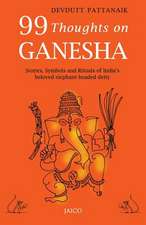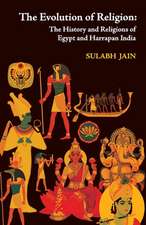River and Goddess Worship in India: Changing Perceptions and Manifestations of Sarasvati: Routledge Hindu Studies Series
Autor R.U.S. Prasaden Limba Engleză Hardback – 30 mai 2017
The book examines Sarasvati’s origin, the course of her flow and the place of her disappearance in a holistic manner. Based on a close analysis of texts from the early Rig-Veda to the Brahmanas and the Puranas, it discusses different view-points in a balanced perspective and attempts to drive the discussions towards the emergence of a consensus view. The author delineates the various phases of Sarasvati’s evolution to establish her unique status and emphasise her continued relevance in the Hindu tradition. The book argues that the practice of pilgrimage further evolved after its association with the river Sarasvati who was perceived as divinity personified in Hindu tradition. This, in turn, led to the emergence of numerous pilgrimage sites on or near her banks which attracted a large number of pilgrims.
A multifaceted and interdisciplinary analysis of a Hindu goddess, this book will be of interest to academics researching South Asian Religion, Hinduism and Indian Philosophy as also the general readers.
| Toate formatele și edițiile | Preț | Express |
|---|---|---|
| Paperback (1) | 381.51 lei 6-8 săpt. | |
| Taylor & Francis – 12 dec 2019 | 381.51 lei 6-8 săpt. | |
| Hardback (1) | 762.97 lei 6-8 săpt. | |
| Taylor & Francis – 30 mai 2017 | 762.97 lei 6-8 săpt. |
Din seria Routledge Hindu Studies Series
-
 Preț: 312.03 lei
Preț: 312.03 lei - 15%
 Preț: 404.27 lei
Preț: 404.27 lei -
 Preț: 469.34 lei
Preț: 469.34 lei - 13%
 Preț: 335.76 lei
Preț: 335.76 lei -
 Preț: 411.42 lei
Preț: 411.42 lei -
 Preț: 484.47 lei
Preț: 484.47 lei - 15%
 Preț: 296.53 lei
Preț: 296.53 lei - 18%
 Preț: 1059.84 lei
Preț: 1059.84 lei - 25%
 Preț: 766.65 lei
Preț: 766.65 lei - 18%
 Preț: 1059.84 lei
Preț: 1059.84 lei -
 Preț: 414.32 lei
Preț: 414.32 lei -
 Preț: 309.69 lei
Preț: 309.69 lei - 26%
 Preț: 765.43 lei
Preț: 765.43 lei - 18%
 Preț: 1054.71 lei
Preț: 1054.71 lei - 15%
 Preț: 455.81 lei
Preț: 455.81 lei -
 Preț: 446.75 lei
Preț: 446.75 lei -
 Preț: 442.68 lei
Preț: 442.68 lei - 12%
 Preț: 300.29 lei
Preț: 300.29 lei -
 Preț: 414.32 lei
Preț: 414.32 lei - 18%
 Preț: 1056.14 lei
Preț: 1056.14 lei - 18%
 Preț: 1057.75 lei
Preț: 1057.75 lei -
 Preț: 486.42 lei
Preț: 486.42 lei -
 Preț: 475.88 lei
Preț: 475.88 lei -
 Preț: 411.85 lei
Preț: 411.85 lei - 18%
 Preț: 1222.16 lei
Preț: 1222.16 lei - 26%
 Preț: 820.73 lei
Preț: 820.73 lei - 15%
 Preț: 466.60 lei
Preț: 466.60 lei - 18%
 Preț: 1057.89 lei
Preț: 1057.89 lei -
 Preț: 469.34 lei
Preț: 469.34 lei -
 Preț: 486.98 lei
Preț: 486.98 lei - 31%
 Preț: 763.39 lei
Preț: 763.39 lei -
 Preț: 411.64 lei
Preț: 411.64 lei - 18%
 Preț: 1002.80 lei
Preț: 1002.80 lei - 26%
 Preț: 762.89 lei
Preț: 762.89 lei - 18%
 Preț: 1339.41 lei
Preț: 1339.41 lei
Preț: 762.97 lei
Preț vechi: 1026.69 lei
-26% Nou
Puncte Express: 1144
Preț estimativ în valută:
145.99€ • 152.84$ • 120.80£
145.99€ • 152.84$ • 120.80£
Carte tipărită la comandă
Livrare economică 05-19 aprilie
Preluare comenzi: 021 569.72.76
Specificații
ISBN-13: 9781138630444
ISBN-10: 1138630446
Pagini: 168
Ilustrații: 4 Line drawings, black and white; 10 Halftones, black and white; 5 Tables, black and white; 14 Illustrations, black and white
Dimensiuni: 156 x 234 x 15 mm
Greutate: 0.39 kg
Ediția:1
Editura: Taylor & Francis
Colecția Routledge
Seria Routledge Hindu Studies Series
Locul publicării:Oxford, United Kingdom
ISBN-10: 1138630446
Pagini: 168
Ilustrații: 4 Line drawings, black and white; 10 Halftones, black and white; 5 Tables, black and white; 14 Illustrations, black and white
Dimensiuni: 156 x 234 x 15 mm
Greutate: 0.39 kg
Ediția:1
Editura: Taylor & Francis
Colecția Routledge
Seria Routledge Hindu Studies Series
Locul publicării:Oxford, United Kingdom
Public țintă
PostgraduateCuprins
1. Introduction
2. Origin of the Vedic river Sarasvati – various theories
3. Sarasvati in ancient Indian texts- an over-view
4. Sarasvati in the Rig-Veda
5. Sarasvati in the Yajur-Veda and the Atharva-Veda
6. Sarasvati in the Brahmanas
7. Sarasvati and other deities in Vedic texts
8. Sarasvati and Vak
9. Sarasvati in the Mahabharata
10. Important pilgrimage sites (Tirthas) on Sarasvati and folklore associated with them
11. Sarasvati and the Puranas
12. Iconography of Sarasvati
13. Conclusions
2. Origin of the Vedic river Sarasvati – various theories
3. Sarasvati in ancient Indian texts- an over-view
4. Sarasvati in the Rig-Veda
5. Sarasvati in the Yajur-Veda and the Atharva-Veda
6. Sarasvati in the Brahmanas
7. Sarasvati and other deities in Vedic texts
8. Sarasvati and Vak
9. Sarasvati in the Mahabharata
10. Important pilgrimage sites (Tirthas) on Sarasvati and folklore associated with them
11. Sarasvati and the Puranas
12. Iconography of Sarasvati
13. Conclusions
Notă biografică
R. U. S. Prasad holds a Ph.D from Jawaharlal Nehru University, India. He is currently an Associate in the Department of South Asian Studies, Harvard University. He is the author of two books on telecommunications and Rig-Vedic and Post-Rig-Vedic Polity.
Recenzii
This is a commendable book, thorough, carefully researched, ground-breaking, and generously sensitive to the multiple dimensions of Sarasvati as goddess and river over the ages. R. U. S. Prasad has very responsibly studied the many and varied relevant texts, and also paid attention to geographical, architectural, and iconographic details. He has taken seriously a very long history, without reducing the meaning of what we learn about Sarasvati simply to historical data. Scholars and believers both will respect this book and benefit from the immense learning it contains. It should quickly become a standard resource for the study of Sarasvati and similar figures in the Vedic and Hindu traditions.
Francis X. Clooney, SJ, Parkman Professor of Divinity and Professor of Comparative Theology and Director, Center for the Study of World Religions, Harvard University, US
This carefully researched study provides an excellent contribution to present controversial debates on the identity of India’s holy river. Of particular relevance in this context is the critical evaluation of the various theories about Sarasvati’s identification with the Helmand river in Afghanistan, the Indus and the seasonal monsoon fed Ghaggar-Hakra river in Haryana and south eastern Pakistan. The main emphasis and significant capacity of the book is the comprehensive analysis of the textual evidence from the Rigveda to the Puranas, depicting the successive stages and facets of Sarasvati’s transformation from a river goddess to the divine embodiment of speech and learning, fine arts and music.
Hermann Kulke, Kiel University, Germany
Dr R.U.S. Prasad’s work reflects a very thorough study of the available evidence on Sarasvati. He has effectively demonstrated within the confines of evidence that Sarasvati was a river in reality eulogized by the Aryans without getting trapped in the quagmire of an irrelevant archaeological debate. Tracing the evolution of Sarasvati through the corpus of later Vedic texts, he has been able to show how the goddess of river gradually merges with goddess of wisdom and learning. The coverage of the pilgrimage sites along the course of the Sarasvati and of the pattern of their clustering mainly in the state of present Haryana is comprehensive; this perhaps derives from the early tradition of the sanctity of Brahmavarta as sacred space par excellence, although by the time the lists of the tirthas were really formalized, their sanctity may have been more notional than functional.
Professor B.D. Chattopadhyaya, Centre for Historical Studies, Jawaharlal Nehru University, India
Francis X. Clooney, SJ, Parkman Professor of Divinity and Professor of Comparative Theology and Director, Center for the Study of World Religions, Harvard University, US
This carefully researched study provides an excellent contribution to present controversial debates on the identity of India’s holy river. Of particular relevance in this context is the critical evaluation of the various theories about Sarasvati’s identification with the Helmand river in Afghanistan, the Indus and the seasonal monsoon fed Ghaggar-Hakra river in Haryana and south eastern Pakistan. The main emphasis and significant capacity of the book is the comprehensive analysis of the textual evidence from the Rigveda to the Puranas, depicting the successive stages and facets of Sarasvati’s transformation from a river goddess to the divine embodiment of speech and learning, fine arts and music.
Hermann Kulke, Kiel University, Germany
Dr R.U.S. Prasad’s work reflects a very thorough study of the available evidence on Sarasvati. He has effectively demonstrated within the confines of evidence that Sarasvati was a river in reality eulogized by the Aryans without getting trapped in the quagmire of an irrelevant archaeological debate. Tracing the evolution of Sarasvati through the corpus of later Vedic texts, he has been able to show how the goddess of river gradually merges with goddess of wisdom and learning. The coverage of the pilgrimage sites along the course of the Sarasvati and of the pattern of their clustering mainly in the state of present Haryana is comprehensive; this perhaps derives from the early tradition of the sanctity of Brahmavarta as sacred space par excellence, although by the time the lists of the tirthas were really formalized, their sanctity may have been more notional than functional.
Professor B.D. Chattopadhyaya, Centre for Historical Studies, Jawaharlal Nehru University, India
Descriere
The book examines Sarasvati’s origin, the course of her flow and the place of her disappearance in a holistic manner. Based on a close analysis of texts from the early Rig-Veda to the Brahmanas and the Puranas, it discusses different view-points in a balanced perspective and attempts to drive the discussions towards the emergence of a consensus view. The author delineates the various phases of Sarasvati’s evolution to establish her unique status and emphasise her continued relevance in the Hindu tradition. The book argues that the practice of pilgrimage further evolved after its association with the river Sarasvati who was perceived as divinity personified in Hindu tradition.





















